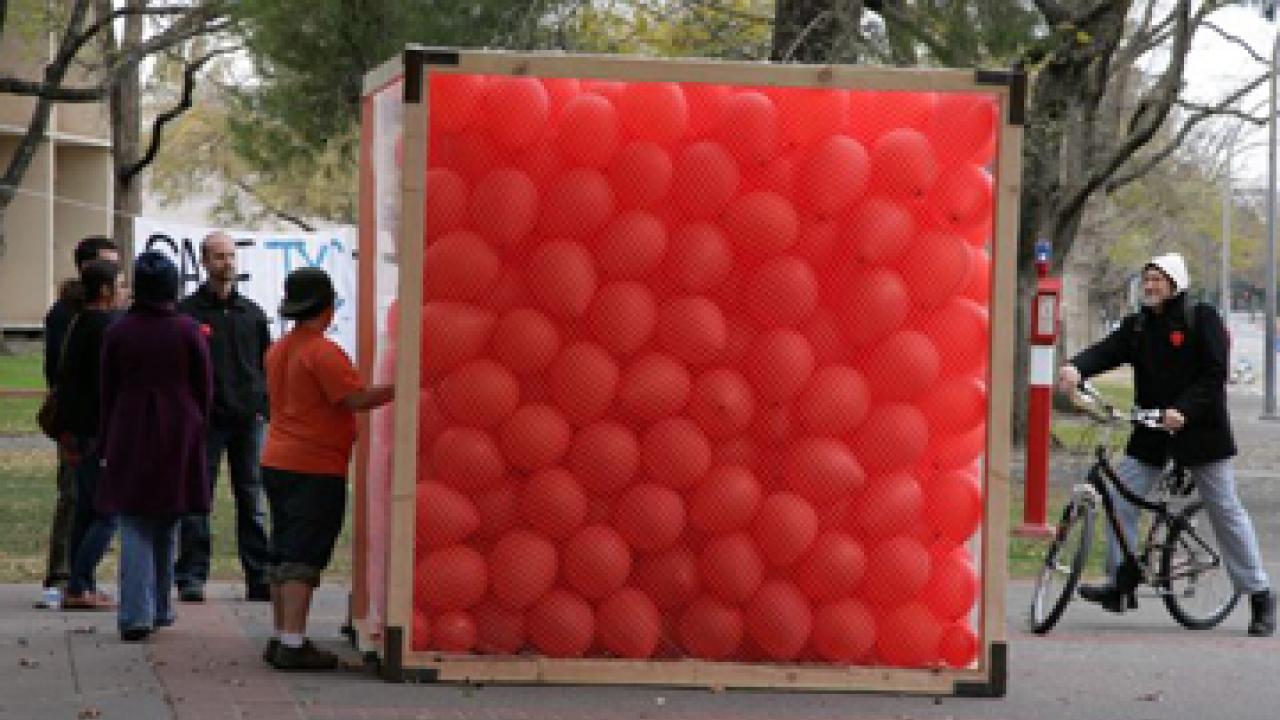Site-specific art is on display once again around the UC Davis campus, as part of an interdisciplinary course titled Where Here Is, presented by the Department of Art and Art History. The artwork is due to be on display through Dec. 14.
Robin Hill, associate professor of art, said the course asks student teams to focus on the idea of “the local” — i.e., the specific sites where the art will be located.
“By massaging each site for meaning (social, cultural, aesthetic, historical), these works of art will define, enhance or transform the places in which they are installed,” Hill said.
The teams include students from art and art history, design, landscape design, nature and culture, English, sociology and more.
“Frequent class discussions-critiques, assigned readings, slide presentations and field trips to area studios and public art sites strengthened presentation skills and deepened students’ understanding of the meaning of site-specificity as it relates to visual art,” Hill said.
Students worked in collaboration with staff from Buildings and Grounds, the arborteum, the Police and Fire departments, and Shields Library, and with conceptual artist Steve Kaltenbach of Davis.
For a copy of the exhibition’s catalog, or for more information, contact Hill by e-mail: rhill@ucdavis.edu.
Artists' statements
Here are the preliminary artists' statements for The "Why?" Project (pictured on the Dateline index page) and Red Space: An Untitled Activation of an Inactive Space (pictured on this page):
Red Space: An Untitled Activation of an Inactive Space, by John Arrambide, Keith Denatale, Ryan Gallant and Shannon Weaver — In our mission statement, we as a group set out to bring attention to space. Our goal as a group is to cause the public to take notice of an aspect of empty space using means such sight coupled with a level of agitation.
What we want to accomplish as a group is to take a space on our campus, one that is unused and generally abandoned, and fill it with activity. What this will achieve in the audience is luring and enticing them to visit the inactive area. We want to reclaim the space for us as a group and for our fellow students.
To do this, we plan to build a structure that encases bright red balloons. The location of the structure will change every day; for an an hour at a time, the group will move the structure to a different spot on campus, activating vacated and forgotten areas.
By placing our activation, the public will stop and be forced to notice the mammoth red structure. The color is agitating to the viewer while also enticing in the way the viewer wants to experience the space inside filled completely with distractions that were never there before.
The “Why?” Project, by Carrie Persson, Thai Tran and Marina Triantafyllou — American consumers purchase 28 billion plastic bottles every year; only 14 percent of these bottles are recycled into usable materials while the rest end up in landfill. In addition, it takes 45 million to 50 million barrels of crude oil per year to make the bottles that contain the milk, juice, water and sodas we love to consume. The oil that is used to manufacture these bottles could provide fuel for more than 1,100,000 vehicles in one year.
Based on this information, we conceived of the idea to collect plastic bottles and turn them into a sculpture that addresses our over-consumption of plastics. We collected 300 1-gallon plastic milk and water jugs as the primary material for our conceptual sculpture of the ultimate question, “Why?”
We believe that “Why” is the ultimate question, that causes us to take more time to contemplate our response to the “Why”. Why is there so much waste? Why has plastic become such an important part of our lives? Why do we need to consume products in such large quantities? Why do we need to consume so much crude oil? Why don’t we use water filters on our faucets?
Inspiration for this project comes from Claes Oldenburg and Coosje van Bruggen, for their very large and whimsical public sculptures. Examples of Oldenburg-van Bruggen works are the floor-to-ceiling light switches in the CBS Building, New York City; the Crusoe Umbrella installed at the civic center in Des Moines, Iowa; and the giant flashlight installed in Las Vegas.
We hope that this whimsical yet serious sculpture will help everyone viewing it to contemplate how they might consume less plastic, and consider the amount of natural resources that go into the plastic manufacturing process
Media Resources
Dave Jones, Dateline, 530-752-6556, dljones@ucdavis.edu
